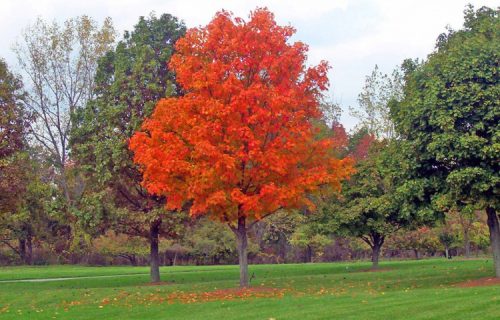Is fall a good time to plant trees and shrubs?

Many people assume that the best time to plant trees and shrubs is in the spring because they have the entire growing season to become established. However, spring weather isn’t always cooperative when it comes to getting plants in the ground. Late snow or excessive rainfall can make the soil too wet and unstable to properly plant. If an extended rainy period is immediately followed by hot, dry summer weather, new trees and shrubs can suffer. This stress manifests as scorched leaves and limited growth. Thus, fall planting becomes an attractive alternative.
Benefits of Planting in the Fall
Planting in the fall has some of the same benefits as planting in the spring. Temperatures are typically cool, causing plants to lose less water through their leaves due to transpiration than they would in hot weather. This makes it less likely for plants to experience stress, and more energy can be directed to root production. When the air temperature drops below that of the soil, shoot growth ceases and roots continue to develop until the soil dips below 40℉. Additionally, the fall tends to see significant precipitation, which also helps woody plants become established. A healthy, well-established root system goes a long way towards ensuring vigorous growth in the spring.
Risks of Planting in the Fall
Planting in the fall is not without risks, and the chance of plant failure increases the later in the season you wait. Aim to give plants at least six weeks of mild weather for root growth before freezing temperatures arrive. While the exact timing of this is impossible to know, early October is a good deadline.
Choosing Appropriate Trees and Shrubs for Fall Planting
As a general rule, deciduous plants are more suitable for fall planting than evergreens. Evergreens, like arborvitae or rhododendrons, lose water through their leaves throughout the winter and are especially susceptible to winter injury before their roots are established. Plants with shallow, fibrous roots are usually the best choices for fall planting because they recover faster than those with large, thick taproots. For this reason, plants like magnolia, tuliptree, oak, and ginkgo are better suited for planting in the spring. Deciduous species that respond well to fall planting include apples, crabapples, lindens, maples, hawthorns, honey locusts and elms. Success is also likely with most deciduous shrubs such as lilacs, witchhazels and forsythia.
Plant Selection and Care for Fall Planting
Important aspects of planting successfully in the fall are choosing healthy plants and planting and caring for them properly. Only purchase plants that have a good structure and are free of diseases, and dead or broken branches. Also make sure there are no signs of girdling roots. After planting, new trees and shrubs should be watered thoroughly and consistently, applying enough water to moisten the soil to a depth of eight to ten inches at least once a week. Continue watering until freezing temperatures arrive. The winter weather in New Hampshire is unpredictable, and even tough plants may not survive if conditions are severe, particularly in early winter. However, fall planting can still be a great option for gardeners to consider.
See more at…https://extension.unh.edu/blog/fall-good-time-plant-trees-and-shrubs